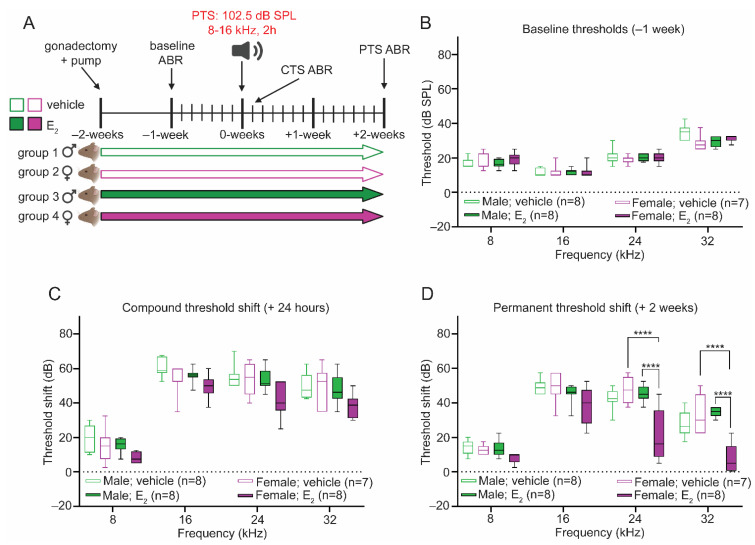Figure 3.
E2-replacement in gonadectomized female mice protects against hearing loss following a PTS-inducing noise exposure. (A) Experimental schematic. Male and female mice were gonadectomized at 8-weeks of age and implanted with an osmotic pump to deliver vehicle or E2 (1 μg/day) for the duration of the study. Animals were exposed to a permanent threshold shift (PTS)-inducing noise (102.5 dB SPL, 8–16 kHz, 2-h) at 10-weeks of age. Auditory thresholds were quantified via ABR measurements 1-week pre-exposure (baseline), 24-h post-exposure (compound threshold shift or CTS), and 2-weeks post-exposure (permanent threshold shift or PTS). (B) Vehicle-treated and E2-treated male and female mice display similar baseline ABR thresholds. (C) Twenty-four hours post-exposure, vehicle-treated and E2-treated male and female mice display a CTS of a similar magnitude at all frequencies examined. (D) Two-weeks post-exposure, E2-treated female mice display a reduced PTS compared to E2-treated males at 24 kHz (p < 0.0001) and 32 kHz (p < 0.0001) and compared to vehicle-treated females at 24 kHz (p < 0.0001) and 32 kHz (p < 0.0001). Vehicle-treated male and female mice display a PTS of a similar magnitude across all frequencies tested. Similarly, vehicle-treated and E2-treated males displayed no differences in the magnitude of the PTS across all frequencies tested. ABR thresholds were compared using a 3-way ANOVA followed by Tukey’s post-hoc test. n = number of mice; ABR thresholds: minimum value, 1st quartile, median, 3rd quartile, maximum value; **** p < 0.0001.

